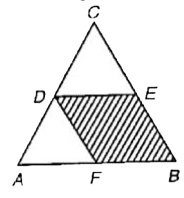Let ABC be a triangle. Three points D, E and F are on the sides AB, AC and BC respectively so that BDEF is a parallelogram. M and N are mid points of the sides DE and EF. If vector ¯¯¯¯¯¯¯¯MN=14¯¯¯¯¯¯AC. Then find the ratio in which D and F divides the sides AB and BC.
To solve the problem, we will follow a systematic approach using vector notation and properties of triangles and parallelograms.
Step 1: Define the Points in Vector Form
Let the position vectors of points A, B, and C be represented as:
- →A=→0 (taking A as the origin)
- →B=→b
- →C=→c
Step 2: Define Points D, E, and F
Let D, E, and F divide the sides AB, AC, and BC in ratios m:1, n:1, and l:1 respectively. The position vectors of these points can be expressed as:
- →D=mm+1→b (on AB)
- →E=nn+1→c (on AC)
- →F=ll+1→b+1l+1→c (on BC)
Step 3: Find Midpoints M and N
The midpoints M and N of segments DE and EF can be calculated as follows:
- →M=→D+→E2=12(mm+1→b+nn+1→c)
- →N=→E+→F2=12(nn+1→c+(ll+1→b+1l+1→c))
Step 4: Calculate Vector MN
Now, we calculate the vector →MN:
→MN=→N−→M
Substituting the expressions for →M and →N:
→MN=12(nn+1→c+ll+1→b+1l+1→c)−12(mm+1→b+nn+1→c)
Step 5: Simplify MN
Combine like terms:
→MN=12((ll+1−mm+1)→b+(n+1l+1−nn+1)→c)
Step 6: Set MN Equal to Given Vector
According to the problem, →MN=14→AC=14(→c−→0)=14→c.
Thus, we have:
12(ll+1−mm+1)=0(coefficient of →b)
12(n+1l+1−nn+1)=14(coefficient of →c)
Step 7: Solve the Equations
From the first equation:
ll+1=mm+1⟹l(m+1)=m(l+1)⟹lm+l=ml+m⟹l=m
From the second equation:
n+1l+1−nn+1=12⟹(after simplification)⟹n=1
Step 8: Find the Ratios
Since l=m and n=1, we can conclude that:
- The ratio in which D divides AB is m:1
- The ratio in which F divides BC is 1:1
Thus, the final ratios are:
- D divides AB in the ratio 1:1
- F divides BC in the ratio 1:1
Let the position vectors of points A, B, and C be represented as:
- →A=→0 (taking A as the origin)
- →B=→b
- →C=→c
Let D, E, and F divide the sides AB, AC, and BC in ratios m:1, n:1, and l:1 respectively. The position vectors of these points can be expressed as:
- →D=mm+1→b (on AB)
- →E=nn+1→c (on AC)
- →F=ll+1→b+1l+1→c (on BC)
The midpoints M and N of segments DE and EF can be calculated as follows:
- →M=→D+→E2=12(mm+1→b+nn+1→c)
- →N=→E+→F2=12(nn+1→c+(ll+1→b+1l+1→c))
Now, we calculate the vector →MN:
→MN=→N−→M
Substituting the expressions for →M and →N:
→MN=12(nn+1→c+ll+1→b+1l+1→c)−12(mm+1→b+nn+1→c)
Combine like terms:
→MN=12((ll+1−mm+1)→b+(n+1l+1−nn+1)→c)
According to the problem, →MN=14→AC=14(→c−→0)=14→c.
Thus, we have:
12(ll+1−mm+1)=0(coefficient of →b)
12(n+1l+1−nn+1)=14(coefficient of →c)
From the first equation:
ll+1=mm+1⟹l(m+1)=m(l+1)⟹lm+l=ml+m⟹l=m
From the second equation:
n+1l+1−nn+1=12⟹(after simplification)⟹n=1
Since l=m and n=1, we can conclude that:
- The ratio in which D divides AB is m:1
- The ratio in which F divides BC is 1:1
- D divides AB in the ratio 1:1
- F divides BC in the ratio 1:1
Topper's Solved these Questions
- MATHEMATICS TIPSBOOK - FIITJEECHAPTER - MATHEMATICS TIPSEXERCISE - ASSIGNMENT (SECTION (I) : MCQ (SINGLE CORRECT)
120 Videos
- MATHEMATICS TIPSBOOK - FIITJEECHAPTER - MATHEMATICS TIPSEXERCISE - ASSIGNMENT -OBJECTIVE
84 Videos
- MATHEMATICS BOOK - FIITJEECHAPTER - MATHEMATICS EXERCISE - NUMERICAL DECIMAL BASED QUESTIONS
15 Videos
- MATRICES BOOK - FIITJEECHAPTER - MATRICES EXERCISE - NUMERICAL BASED
3 Videos
Similar Questions
Knowledge Check
In a triangle ABC, D, E, F are the mid-points of the sides BC, CA and AB respectively , the vector →AD is equal to
A→BE+→CFB→BE−→CFC→CF−→BED−→BE−→CFIn a ΔABC,D,E,F are the mid -points of the sides BC, CA and AB respectively, the vector AD is equal to
A−−→BE+−−→CFB−−→BE−−−→CFC−−→CF−−−→BED−−−→BE−−−→CFABC is a triangle and D,E,F are the mid-points of the sides BC,CA, AB respectively . The ratio of the areas of ΔABCandΔDEF is :
A4:1B5:1C3:1Dcan't be determind
In the adjoining figure D, E and F are the mid-points of the sides BC, AC and AB respectively. △DEF is congruent to triangle :

View SolutionABC is a triangle in which D, E and F are the mid-points of the sides AC, BC and AB respectively. What is the ratio of the area of the shaded to the unshaded region in the triangle?

View SolutionD, E, F are the mid points of side AB, BC, AC prove that BDEF is a parallelogram whose area is half that of Δ ABC
View SolutionIn ΔABC,MandN are points on the sides AB and AC respectively such that BM=CN. If ∠A=∠C then show that MN∣∣BC.
View SolutionABC is a triangle and D,E,F are the mid-points of the sides BC,CA, AB respectively . The ratio of the areas of ΔABCandΔDEF is :
View Solution

